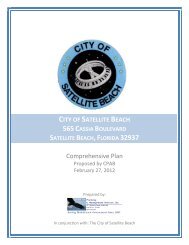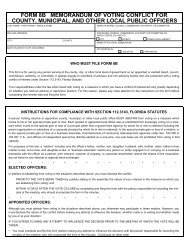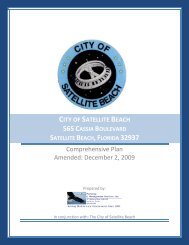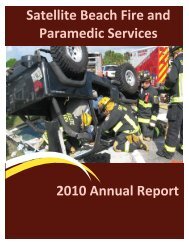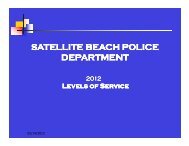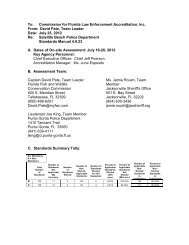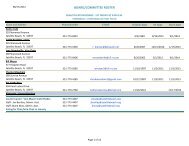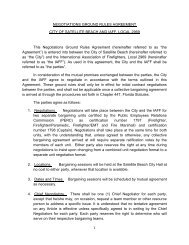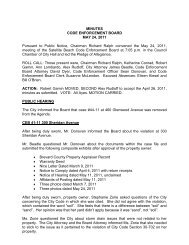Supporting Documents (Data and Analysis) - Satellite Beach
Supporting Documents (Data and Analysis) - Satellite Beach
Supporting Documents (Data and Analysis) - Satellite Beach
Create successful ePaper yourself
Turn your PDF publications into a flip-book with our unique Google optimized e-Paper software.
Collector roadways carry a moderate volume of traffic at moderate speeds. Property access is<br />
an appropriate function of this facility, provided it does not inhibit local traffic movement.<br />
Municipal/City (Minor) Collector - Similar in function to that of a major collector, a minor<br />
collector is intended to serve a smaller geographic area. It often connects to major collectors<br />
<strong>and</strong> arterial roadways. Property access is generally a significant function of this facility. The<br />
City of <strong>Satellite</strong> <strong>Beach</strong> has designated collectors as shown on the Existing Roadways<br />
Characteristics Map.<br />
Local - A roadway or street having the primary purpose of providing access to adjacent<br />
property. Mobility is a secondary function. Average speeds <strong>and</strong> volumes are low; trips are<br />
usually of short duration with a purpose of connecting with a higher order facility. A local<br />
road should not carry through traffic. The trip being served should originate or be destined<br />
for the immediate surrounding area.<br />
Lane Geometry<br />
The number of through-lanes that exist within the City of <strong>Satellite</strong> <strong>Beach</strong> at this time are depicted on<br />
the Existing Roadways Characteristics Map. The existing number of lanes are also shown for arterial<br />
<strong>and</strong> collector roadways within the City. All other roadways are two (2) lanes.<br />
Traffic Signals<br />
The Existing Roadways Characteristics Map shows the location of the six (6) signalized intersections<br />
within the City of <strong>Satellite</strong> <strong>Beach</strong>.<br />
Level of Service/Roadway Capacity/Service Volumes<br />
Roadway Level of Service (LOS) is a qualitative measure of the efficiency of roadway operation.<br />
LOS is generally described through the assignment of highway segment or intersection operating<br />
“grades” ranging from LOS “A” (excellent) to LOS “F” (poor). A summary LOS grade is assigned<br />
through a quantitative comparison of traffic volume relative to roadway capacity.<br />
Highway capacity constitutes, under controlled conditions, the maximum number of vehicles which<br />
could pass a given point within a given period (usually daily or peak hour). Service volume relates<br />
to the number of vehicles that could be anticipated to pass the same point with less driver duress -<br />
that is, at a desired level of service.<br />
Existing Traffic Volumes<br />
The City is served by two north-south arterials <strong>and</strong> several collector roadways. Because of the City’s<br />
residential nature <strong>and</strong> constraints due to its geography, this roadway system provides the necessary<br />
means of circulation within <strong>and</strong> among residential areas; the City has also undertaken an ambitious<br />
effort to develop a network of paved, off-road pedestrian/bicycle paths (i.e., sidewalks) within rights-<br />
Transportation Element<br />
<strong>Data</strong> <strong>and</strong> <strong>Analysis</strong> 2-3



